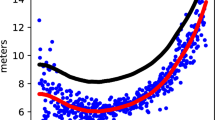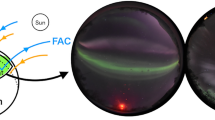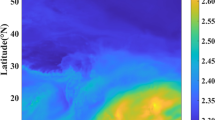Abstract
The Massachusetts Institute of Technology (MIT) Haystack Observatory provides the ionospheric Total Electron Content (TEC) data with a temporal resolution of 5 minutes and limited spatial coverage, as they do not provide data where there are no TEC measurements. To improve the spatial coverage of MIT-TEC, we have proposed an approach for constructing a global ionospheric map of TEC with a time resolution of 5 minutes and a grid spacing of 1° × 1° in latitude and longitude. The global ionospheric TEC map constructed by the spherical harmonic (SH) function and MIT-TEC (SHMIT-TEC) is compared with the original MIT-TEC data. The results show that SHMIT-TEC can clearly present the properties of the ionospheric distribution. The average values of Standard Deviations (STDs) between SHMIT-TEC and MIT-TEC are about 4.1448 TECU and 3.1382 TECU in the high solar activity year (2003) and low solar activity year (2008), respectively. Compared to TECs provided by the Center for Orbit Determination in Europe (CODE), SHMIT-TEC can also accurately reflect the diurnal and latitudinal variations of the ionospheric TEC. Furthermore, SHMIT-TEC is utilized to investigate the ionospheric response to the solar flare on 28 October 2003. The results show that the SHMIT-TEC updated in 5 minutes can accurately detect the time of obvious TEC enhancement (11:07 universal time, UT) induced by the solar flare, which is in accordance with the peak times of X-ray flux in 0.1–0.8 nm (11:10 UT) measured by the Geostationary Operational Environment Satellite and extreme ultraviolet (EUV) fluxes (11:06 UT) observed from the solar EUV monitor experiment. In contrast to MIT-TEC and CODE-TEC, SHMIT-TEC with global coverage and high temporal and spatial resolution can monitor the ionospheric TEC response to space weather events quickly and effectively.










Similar content being viewed by others
Data Availability
GPS TEC data are downloaded from the Institute of Geology and Geophysics, Chinese Academy of Sciences (available at http://madrigal.iggcas.ac.cn/madrigal/). CODE-GIM data can be accessed at ftp://cddis.gsfc.nasa.gov/gps/products/ionex/. The H-alpha solar flare reports and X-ray flux data are provided by the National Geophysical Data Center (ftp://ftp.ngdc.noaa.gov/). The EUV flux data are from the solar extreme ultraviolet monitor on board SOHO (available at http://www.usc.edu/).
References
Aa, E., Huang, W., Yu, S., Liu, S., Shi, L., Gong, J., Chen, Y., Shen, H.: A regional ionospheric TEC mapping technique over China and adjacent areas on the basis of data assimilation. J. Geophys. Res. Space Phys. 120(6), 5049–5061 (2015)
Afraimovich, E.L., Altyntsev, A.T., Kosogorov, E.A., Larina, N.S., Leonovich, L.A.: Ionospheric effects of the solar flares of September 23, 1998 and July 29, 1999 as deduced from global GPS network data. J. Atmos. Sol.-Terr. Phys. 63(17), 1841–1849 (2001)
Alsamamra, H., Ruiz-Arias, J.A., Pozo-Vázquez, D., Tovar-Pescador, J.: A comparative study of ordinary and residual Kriging techniques for mapping global solar radiation over southern Spain. Agric. For. Meteorol. 149(8), 1343–1357 (2009)
Camargo, P.O.D., Monico, J.F.G., Ferreira, L.D.D.: Application of ionospheric corrections in the equatorial region for L1 GPS users. Earth Planets Space 52(11), 1083–1089 (2000)
Chen, Z., Zhang, S.R., Coster, A.J., Fang, G.: EOF analysis and modeling of GPS TEC climatology over North America. J. Geophys. Res. Space Phys. 120(4), 3118–3129 (2015)
Donnelly, R.F.: Contribution of X-ray and EUV bursts of solar flares to sudden frequency deviations. J. Geophys. Res. 74, 255–259 (1969)
Durmaz, M., Karslioğlu, M.O.: Non-parametric regional VTEC modeling with multivariate adaptive regression B-splines. Adv. Space Res. 48(9), 1523–1530 (2011)
Durmaz, M., Karslioğlu, M.O., Nohutcu, M.: Regional VTEC modeling with multivariate adaptive regression splines. Adv. Space Res. 46(2), 180–189 (2010)
Foster, M., Evans, A.: An evaluation of interpolation techniques for reconstructing ionospheric TEC maps. IEEE Trans. Geosci. Remote Sens. 46(7), 2153–2164 (2008)
Hernández-Pajares, M., Juan, J.M., Sanz, J., Orus, R., Garcia-Rigo, A., Feltens, J., Komjathy, A., Schaer, S.C., Krankowski, A.: The IGS VTEC maps: a reliable source of ionospheric information since 1998. J. Geod. 83(3–4), 263–275 (2009)
Hernández-Pajares, M., García-Rigo, A., Juan, J.M., Sanz, J., Monte, E., Aragón-Àngel, A.: GNSS measurement of EUV photons flux rate during strong and mid solar flares. Space Weather 10(12), 1–16 (2012)
Huo, X.L., Yuan, Y.B., Ou, J.K., Zhang, K.F., Bailey, G.J.: Monitoring the global-scale winter anomaly of total electron contents using GPS data. Earth Planets Space 61(8), 1019–1024 (2009)
Li, Z., Yuan, Y., Wang, N., Hernández-Pajares, M., Huo, X.: SHPTS: towards a new method for generating precise global ionospheric TEC map based on spherical harmonic and generalized trigonometric series functions. J. Geod. 89(4), 331–345 (2015)
Liu, J., Chen, R., Wang, Z., Zhang, H.: Spherical cap harmonic model for mapping and predicting regional TEC. GPS Solut. 15(2), 109–119 (2011)
Mahajan, K.K., Lodhi, N.K., Upadhayaya, A.K.: Observations of X-ray and EUV fluxes during X-class solar flares and response of upper ionosphere. J. Geophys. Res. 115, A12330 (2010). https://doi.org/10.1029/2010JA015576
Mannucci, A.J., Wilson, B.D., Yuan, D.N., Ho, C.H., Lindqwister, U.J., Runge, T.F.: A global mapping technique for GPS-derived ionospheric total electron content measurements. Radio Sci. 33(3), 565–582 (1998)
Mao, T., Wan, W., Yue, X., Sun, L., Zhao, B., Guo, J.: An empirical orthogonal function model of total electron content over China. Radio Sci. 43, RS2009 (2008). https://doi.org/10.1029/2007RS003629
Mautz, R., Ping, J., Heki, K., Schaffrin, B., Shum, C., Potts, L.: Efficient spatial and temporal representations of global ionosphere maps over Japan using B-spline wavelets. J. Geod. 78(11–12), 662–667 (2005)
Ohshio, M.: Negative sudden phase anomaly. Nature 229, 239–240 (1971)
Orús, R., Hernández-Pajares, M., Juan, J.M., Sanz, J.: Improvement of global ionospheric VTEC maps by using Kriging interpolation technique. J. Atmos. Sol.-Terr. Phys. 67(16), 1598–1609 (2005)
Oryema, B., Jurua, E., D’ujanga, F.M., Ssebiyonga, N.: Investigation of TEC variations over the magnetic equatorial and equatorial anomaly regions of the African sector. Adv. Space Res. 56(9), 1939–1950 (2015)
Ping, J., Kono, Y., Matsumoto, K., Otsuka, Y., Saito, A., Shum, C., Heki, K., Kawano, N.: Regional ionosphere map over Japanese islands. Earth Planets Space 54(12), e13–e16 (2002)
Rideout, W., Coster, A.: Automated GPS processing for global total electron content data. GPS Solut. 10(3), 219–228 (2006)
Schunk, R.W., Nagy, A.F.: Ionospheres. Cambridge University Press, New York (2000)
She, C., Wan, W., Yue, X., Xiong, B., Yu, Y., Ding, F., Zhao, B.: Global ionospheric electron density estimation based on multisource TEC data assimilation. GPS Solut. 21(3), 1125–1137 (2017)
Stolle, C., Manoj, C., Luür, H., Maus, S., Alken, P.: Estimating the daytime equatorial ionization anomaly strength from electric field proxies. J. Geophys. Res 113, A09310 (2008). https://doi.org/10.1029/2007JA012781
Tsurutani, B.T., Judge, D.L., Guarnieri, F.L., Gangopadhyay, P., Jones, A.R., Nuttall, J., Zambon, G.A., Didkovsky, L., Mannucci, A.J., Iijima, B., Meier, R.R., Immel, T.J., Woods, T.N., Prasad, S., Floyd, L., Huba, J., Solomon, S.C., Straus, P., Viereck, R.: The October 28, 2003 extreme EUV solar flare and resultant extreme ionospheric effects: comparison to other Halloween events and the Bastille Day event. Geophys. Res. Lett. 32(3), L03S09 (2005). https://doi.org/10.1029/2004GL021475
Wan, W., Liu, L., Yuan, H., Ning, B., Zhang, S.: The GPS measured SITEC caused by the very intense solar flare on July 14, 2000. Adv. Space Res. 36(12), 2465–2469 (2005)
Wan, W., Ding, F., Ren, Z., Zhang, M., Liu, L., Ning, B.: Modeling the global ionospheric total electron content with empirical orthogonal function analysis. Sci. China, Technol. Sci. 55(5), 1161–1168 (2012)
Woods, T.N., Eparvier, F.G., Fontenla, J., Harder, J., Kopp, G., McClintock, W.E., Rottman, G., Smiley, B., Snow, M.: Solar irradiance variability during the October 2003 solar storm period. Geophys. Res. Lett. 31(10), L10802 (2004). https://doi.org/10.1029/2004GL019571
Xiong, B., Wan, W., Liu, L., Paul, W., Zhao, B., Ning, B., Wei, Y., Le, H., Ren, Z., Chen, Y., He, M., Liu, J.: Ionospheric response to the X-class solar flare on 7 September 2005. J. Geophys. Res. Space Phys. 116(A11), 530–538 (2011)
Xiong, B., Wan, W., Ning, B., Ding, F., Hu, L., Yu, Y.: A statistic study of ionospheric solar flare activity indicator. Space Weather 12(1), 29–40 (2014a)
Xiong, B., Wan, W., Zhao, B., Yu, Y., Wei, Y., Ren, Z., Liu, J.: Response of the American equatorial and low-latitude ionosphere to the X1. 5 solar flare on 13 September 2005. J. Geophys. Res. Space Phys. 119(12), 10,336–10,347 (2014b)
Xiong, B., Wan, W., Yu, Y., Hu, L.: Investigation of ionospheric TEC over China based on GNSS data. Adv. Space Res. 58(6), 867–877 (2016)
Xiong, B., Li, X., Wan, W., She, C., Hu, L., Ding, F., Zhao, B.: A method for estimating GNSS instrumental biases and its application based on a receiver of multisystem. Chin. J. Geophys. 62(4), 1199–1209 (2019)
Xiong, B., Li, X., Wang, Y., Zhang, H., Liu, Z., Ding, F., Zhao, B.: Prediction of ionospheric TEC over China based on long and short-term memory neural network. Chin. J. Geophys. 65(7), 2365–2377 (2022)
Yin, J., Ng, S.H., Ng, K.M.: Kriging metamodel with modified nugget-effect: the heteroscedastic variance case. Comput. Ind. Eng. 61(3), 760–777 (2011)
Yu, T., Wan, W., Liu, L., Zhao, B.: Global scale annual and semi-annual variations of daytime NmF2 in the high solar activity years. J. Atmos. Sol.-Terr. Phys. 66(18), 1691–1701 (2004)
Yuan, Y., Ou, J.: Preliminary results and analyses of using IGS GPS data to determine global ionospheric TEC. Prog. Nat. Sci. 13(6), 446–450 (2003)
Yuan, Y., Ou, J.: A generalized trigonometric series function model for determining ionospheric delay. Prog. Nat. Sci. 14(11), 1010–1014 (2004)
Yue, X., Schreiner, W.S., Kuo, Y.H., Hunt, D.C., Wang, B., Solomon, S.C., Burns, A.G., Bilitza, D., Liu, J.Y., Wan, W., Wickert, J.: Global 3-D ionospheric electron density reanalysis based on multisource data assimilation. J. Geophys. Res. 117, A09325 (2012). https://doi.org/10.1029/2012JA017968
Zhang, D.H., Xiao, Z.: Study of ionospheric response to the 4B flare on 28 October 2003 using International GPS Service network data. J. Geophys. Res. 117, A09325 (2005). https://doi.org/10.1029/2012JA017968
Zhang, D.H., Xiao, Z., Igarashi, K., Ma, G.Y.: GPS-derived ionospheric total electron content response to a solar flare that occurred on 14 July 2000. Radio Sci. 37(5), 1086 (2002). https://doi.org/10.1029/2001RS002542.
Zheng, J., Zhao, B., Xiong, B., Wan, W.: Spatial and temporal analysis of the total electron content over China during 2011–2014. Adv. Space Res. 57(12), 2470–2478 (2016)
Acknowledgements
The authors thank the Massachusetts Institute of Technology for providing GPS TEC data products. We thank CODE for providing GIM data. We also thank the National Geophysical Data Center for providing H-alpha solar flare reports and X-ray flux data. The authors extended their acknowledgment to the University of Southern California for providing the EUV flux data.
Funding
This work was supported by the Natural Science Funds of Hebei (Grant No. D2022502001 and D2019502010), Fundamental Research Funds for the Central Universities (2018MS128), the National Natural Science Foundation of China (41574151, 41574162, and 41404127) and the National High Technology Research and Development Program of China (2014AA123503). GPS TEC data products and access through the Madrigal distributed data system are provided to the community by the Massachusetts Institute of Technology with the support of the US National Science Foundation (Grant No. AGS-1242204).
Author information
Authors and Affiliations
Contributions
The authors Bo Xiong, Yuqing Wang, Xiaolin Li, and Yuxiao Li are involved in writing the manuscript. Yuqing Wang contributed to the final version of the manuscript. You Yu provided critical feedback with technical details and helped shape the research. Bo Xiong and Xiaolin Li prepared figures 1-10. All authors reviewed the manuscript.
Corresponding author
Ethics declarations
Conflict of Interest
The authors declare that they have no competing interests.
Competing interests
The authors declare no competing interests.
Additional information
Publisher’s Note
Springer Nature remains neutral with regard to jurisdictional claims in published maps and institutional affiliations.
Rights and permissions
Springer Nature or its licensor holds exclusive rights to this article under a publishing agreement with the author(s) or other rightsholder(s); author self-archiving of the accepted manuscript version of this article is solely governed by the terms of such publishing agreement and applicable law.
About this article
Cite this article
Xiong, B., Wang, Y., Li, X. et al. Constructing a global ionospheric TEC map with a high spatial and temporal resolution by spherical harmonic functions. Astrophys Space Sci 367, 85 (2022). https://doi.org/10.1007/s10509-022-04120-y
Received:
Accepted:
Published:
DOI: https://doi.org/10.1007/s10509-022-04120-y




